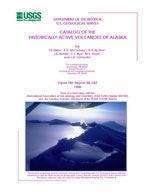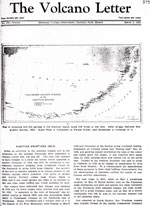Gareloi 1929/4
Start: April 1929 [1]
Stop: 1930 [2]
Event Type: Explosive
Max VEI: 3 [3]
- Tephrafall [1]
- Tephra plume [1]
- Debris-avalanche, volcanic avalanche, or landslide [6]
- Directed blast [6]
Description: Coombs and others (2008) provide information about the 1929 eruption as follows: "The 1929 eruption is the largest historical eruption of Gareloi and also unique in its eruptive style and composition. The most detailed description of the eruption is given by oats (1959) who summarized the first-hand observations of William H. Dirks, Sr. (Coats, 1959; p. 2): 'In April of 1929, there was an eruption. A terrible quake * * * split the mountain from its crater right to the beach. Ashes fell, completely covering their cabins and boats* * * '
"Coats further elaborated on the series of events from observations of the deposits, which were 17 years old when he visited the island and still unmodified either by vegetation or further eruptive activity. According to Coats, the eruption excavated 13 explosion craters, ranging in diameter from 80 to 1,600 m, along a 4.3-km-long, south-southeast trending fissure [see figs. 5 and 7 in original text]. On the basis of work by Coats (1959) and our fieldwork, the eruption began with formation of the current South Peak crater and a possible directed blast to the south. Following this, an explosive eruption covered the southern half of the island in several meters of tephra fall [see fig. 8 in original text]. At this time, the upper craters were excavated. Small pyroclastic flow deposits are interbedded with tephra-fall deposits, indicating that pyroclastic flows accompanied tephra fall.
"During the second half of the eruption, the composition of the juvenile clasts in the fall deposits became more mafic; craters formed lower on the flank, and small lava flows effused from them. Sometime after explosive activity ceased, debris flows from the summit carried hydrothermally altered blocks down the volcano's southern slope.
"The eruption's total volume is unknown, as much of the ejecta were deposited offshore. Onland pyroclastic deposits represent about 16,000 cubic m, and that of lava is about 2,500 cubic m."
Miller and others (1998), also summarize Coats (1956): "In April of 1929, a phreatic eruption opened an elongate crater 1600 m in maximum diameter just below the southern summit; further explosions produced 12 smaller craters aligned along a south- to southeast-trending fissure. Glassy pumice, lapilli, scoria, and accidental rocks were then ejected from the lower craters, blanketing an area roughly 2.5 by 5 km on the southeast slope. Ash layers up to 2 m thick on Ogliuga Island, located about 16 km southeast, may be attributable at least in part to this eruption (Coats, 1956, p. 92) and several centimeters of pyroclastic debris are known to have fallen on Atka Island (about 300 km eastward) during the event. Extrusion of lava, which formed short steep flows, occurred at four sites along the fissure after the tephra eruptions. Various metallic oxides and halides (including atacamite, paratacamite and hematite) were deposited in several of the lower craters. Activity may have continued into 1930.
"Juvenile material erupted in 1929 may be significantly more siliceous than the older basaltic or basaltic andesite rocks. The lava was apparently highly viscous and generally formed blocky, vesicular, or scoriaceous flows, one of which is 75 m wide and 15 m thick. Orthopyroxene, brown hornblende, plagioclase (average composition about An48), and clinopyroxene were observed in lava flows and pyroclastics of the 1929 eruption (Coats, 1959, p. 254-255)."
Finch (1931): "Gareloi volcano, a peak 5,334 feet high far to the west in the Aleutian Islands, was very active during the spring and summer of 1930. The appearance of half of the island was said to be changed by lava flows from fissures, and a hut was destroyed belonging to fox farmers."
Jaggar (1932): "Gareloi in the western Aleutians was said to erupt so violently in 1930 as to change its appearance by lava flows from fissures."
"Coats further elaborated on the series of events from observations of the deposits, which were 17 years old when he visited the island and still unmodified either by vegetation or further eruptive activity. According to Coats, the eruption excavated 13 explosion craters, ranging in diameter from 80 to 1,600 m, along a 4.3-km-long, south-southeast trending fissure [see figs. 5 and 7 in original text]. On the basis of work by Coats (1959) and our fieldwork, the eruption began with formation of the current South Peak crater and a possible directed blast to the south. Following this, an explosive eruption covered the southern half of the island in several meters of tephra fall [see fig. 8 in original text]. At this time, the upper craters were excavated. Small pyroclastic flow deposits are interbedded with tephra-fall deposits, indicating that pyroclastic flows accompanied tephra fall.
"During the second half of the eruption, the composition of the juvenile clasts in the fall deposits became more mafic; craters formed lower on the flank, and small lava flows effused from them. Sometime after explosive activity ceased, debris flows from the summit carried hydrothermally altered blocks down the volcano's southern slope.
"The eruption's total volume is unknown, as much of the ejecta were deposited offshore. Onland pyroclastic deposits represent about 16,000 cubic m, and that of lava is about 2,500 cubic m."
Miller and others (1998), also summarize Coats (1956): "In April of 1929, a phreatic eruption opened an elongate crater 1600 m in maximum diameter just below the southern summit; further explosions produced 12 smaller craters aligned along a south- to southeast-trending fissure. Glassy pumice, lapilli, scoria, and accidental rocks were then ejected from the lower craters, blanketing an area roughly 2.5 by 5 km on the southeast slope. Ash layers up to 2 m thick on Ogliuga Island, located about 16 km southeast, may be attributable at least in part to this eruption (Coats, 1956, p. 92) and several centimeters of pyroclastic debris are known to have fallen on Atka Island (about 300 km eastward) during the event. Extrusion of lava, which formed short steep flows, occurred at four sites along the fissure after the tephra eruptions. Various metallic oxides and halides (including atacamite, paratacamite and hematite) were deposited in several of the lower craters. Activity may have continued into 1930.
"Juvenile material erupted in 1929 may be significantly more siliceous than the older basaltic or basaltic andesite rocks. The lava was apparently highly viscous and generally formed blocky, vesicular, or scoriaceous flows, one of which is 75 m wide and 15 m thick. Orthopyroxene, brown hornblende, plagioclase (average composition about An48), and clinopyroxene were observed in lava flows and pyroclastics of the 1929 eruption (Coats, 1959, p. 254-255)."
Finch (1931): "Gareloi volcano, a peak 5,334 feet high far to the west in the Aleutian Islands, was very active during the spring and summer of 1930. The appearance of half of the island was said to be changed by lava flows from fissures, and a hut was destroyed belonging to fox farmers."
Jaggar (1932): "Gareloi in the western Aleutians was said to erupt so violently in 1930 as to change its appearance by lava flows from fissures."
Impact: From Coats (1959), citing Mr. Oliver, who cites William H. Dirks Sr., the oldest resident of Atka "In April of 1929 there was an eruption. A terrible quake * * * split the mountain from its crater right to the beach. Ashes fell, completely covering their cabins and boats which to this day still remain covered." Finch (1931) states that a hut belonging to fox farmers was destroyed. [1] [2]
Images
References Cited
[1] Geologic reconnaissance of Gareloi Island, Aleutian Islands, Alaska, 1959
Coats, R. R., 1959, Geologic reconnaissance of Gareloi Island, Aleutian Islands, Alaska: in Investigations of Alaskan volcanoes, U.S. Geological Survey Bulletin 1028-J, p. 249-256, 1 sheet, scale unknown.[2] Notes from the Aleutian Islands, 1931
Finch, R. H., 1931, Notes from the Aleutian Islands: The Volcano Letter, v. 357, p. 2-3.[3] Volcanoes of the world [2nd edition], 1994
Simkin, Tom, and Siebert, Lee, 1994, Volcanoes of the world [2nd edition]: Tucson, Arizona, Geoscience Press, 349 p.[4] Reconnaissance geology of some western Aleutian Islands, Alaska, 1956
Coats, R. R., 1956, Reconnaissance geology of some western Aleutian Islands, Alaska: in Investigations of Alaskan volcanoes, U.S. Geological Survey Bulletin 1028-E, p. 83-100, 1 sheet, scale unknown.[5] Catalog of the historically active volcanoes of Alaska, 1998
Miller, T. P., McGimsey, R. G., Richter, D. H., Riehle, J. R., Nye, C. J., Yount, M. E., and Dumoulin, J. A., 1998, Catalog of the historically active volcanoes of Alaska: U.S. Geological Survey Open-File Report 98-0582, 104 p.[6] Preliminary volcano-hazard assessment for Gareloi Volcano, Gareloi Island, Alaska, 2008
Coombs, M.L., McGimsey, R.G., and Browne, B.L., 2008, Preliminary volcano-hazard assessment for Gareloi Volcano, Gareloi Island, Alaska: U.S. Geological Survey Scientific Investigations Report 2008-5159, 29 p., 1 sheet, available at https://pubs.usgs.gov/sir/2008/5159/.Complete Eruption References
Mechanisms of magmatic degassing and eruption triggering at Alaska volcanoes - experimental controls and natural system analogues, 2024
Graham, N.A., 2024, Mechanisms of magmatic degassing and eruption triggering at Alaska volcanoes: experimental controls and natural system analogues: Fairbanks, Alaska, University of Alaska Fairbanks, Ph.D. dissertation, 307 p.
Preliminary volcano-hazard assessment for Gareloi Volcano, Gareloi Island, Alaska, 2008
Coombs, M.L., McGimsey, R.G., and Browne, B.L., 2008, Preliminary volcano-hazard assessment for Gareloi Volcano, Gareloi Island, Alaska: U.S. Geological Survey Scientific Investigations Report 2008-5159, 29 p., 1 sheet, available at https://pubs.usgs.gov/sir/2008/5159/.

Catalog of the historically active volcanoes of Alaska, 1998
Miller, T. P., McGimsey, R. G., Richter, D. H., Riehle, J. R., Nye, C. J., Yount, M. E., and Dumoulin, J. A., 1998, Catalog of the historically active volcanoes of Alaska: U.S. Geological Survey Open-File Report 98-0582, 104 p.

Volcanoes of the world [2nd edition], 1994
Simkin, Tom, and Siebert, Lee, 1994, Volcanoes of the world [2nd edition]: Tucson, Arizona, Geoscience Press, 349 p.
Hard Copy held by AVO at FBKS - CEC shelf
Geologic reconnaissance of Gareloi Island, Aleutian Islands, Alaska, 1959
Coats, R. R., 1959, Geologic reconnaissance of Gareloi Island, Aleutian Islands, Alaska: in Investigations of Alaskan volcanoes, U.S. Geological Survey Bulletin 1028-J, p. 249-256, 1 sheet, scale unknown.

Reconnaissance geology of some western Aleutian Islands, Alaska, 1956
Coats, R. R., 1956, Reconnaissance geology of some western Aleutian Islands, Alaska: in Investigations of Alaskan volcanoes, U.S. Geological Survey Bulletin 1028-E, p. 83-100, 1 sheet, scale unknown.

Volcanic activity in the Aleutian Arc, 1950
Coats, R. R., 1950, Volcanic activity in the Aleutian Arc: U.S. Geological Survey Bulletin 0974-B, p. 35-49, 1 sheet, scale 1:5,000,000.

Aleutian eruptions 1930-1932, 1932
Jaggar, T. A., 1932, Aleutian eruptions 1930-1932: The Volcano Letter, v. 375, p. 1-4.

Aniakchak, the moon crater explodes, 1932
Hubbard, B. R., 1932, Aniakchak, the moon crater explodes: The Saturday Evening Post, v. Jan. 2, p. 6.
Hard Copy held by AVO at FBKS - CEC file cabinet
Notes from the Aleutian Islands, 1931
Finch, R. H., 1931, Notes from the Aleutian Islands: The Volcano Letter, v. 357, p. 2-3.
